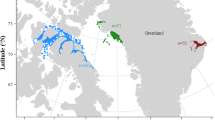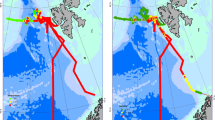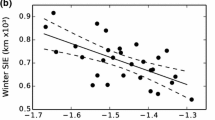Abstract
The Ross Sea pelagic food web is closely coupled, with the foraging among abundant upper level species affecting the foraging of one another. To investigate the roles cetaceans may have in such interspecific interactions in this system, we studied within-season and interannual occurrence patterns of Antarctic minke whales (Balaenoptera bonaerensis) and type-B and type-C killer whales (Orcinus orca) within the southwestern Ross Sea, 2002–2015. Time series analysis summarized daily observations made from 3 shore localities: Capes Crozier, Bird, and Royds distributed around the ~120 km periphery of Ross Island. In early mid-November, both species arrived at Crozier, the easternmost point and westward edge of the Ross Sea Polynya marginal ice zone. Subsequently, coinciding with decreased sea ice cover and numbers off Crozier, both species appeared off Bird, then Royds, 80 and 117 km to the west/southwest, respectively. Arrival in either area coincided with SIC decreasing to <80%, consistent with observations elsewhere. Within-season off Crozier, both species occurred in cycles of multi-day presence followed by absence, perhaps reflecting the spatio-temporal patchiness of prey indicated also by penguin foraging patterns. Within-season off Royds, especially for killer whales, occurrence was even more episodic; type-Bs arrived before type-Cs, and results support previously described resident and transient portions of the type-C population. Combined with results showing that whale arrival leads to food stress among penguins, we suggest that relatively few cetaceans can alter food availability to alter the foraging behavior of other mesopredators, despite primary productivity being the richest in the Southern Ocean.








Similar content being viewed by others
References
Ainley DG (1985) The biomass of birds and mammals in the Ross Sea, Antarctica. In: Seigfried WR, Condy PR, Laws RM (eds) Antarctic nutrient cycles and food webs. Proc. 4th SCAR symposium on Antarctic biology. Springer, Berlin, pp 498–515
Ainley DG (2007) Insights from study of the last intact neritic marine system. Trends Ecol Evol 22:444–445
Ainley DG, Ballard G (2012) Trophic Interactions and the decrease in Killer Whale (Orcinus orca) prevalence with reduced availability of large fish in the southern Ross Sea. Aquat Mammal 38:153–160
Ainley DG, Jacobs SS (1981) Affinity of seabirds for ocean and ice boundaries in the Antarctic. Deep-Sea Res 28A:1173–1185
Ainley DG, Ballard G, Karl BJ, Dugger KM (2005) Leopard seal predation rates at penguin colonies of different size. Antarct Sci 17:335–340
Ainley DG, Ballard G, Dugger KM (2006) Competition among penguins and cetaceans reveals trophic cascades in the Ross Sea, Antarctica. Ecology 87:2080–2093
Ainley DG, Dugger KM, Toniolo V, Gaffney I (2007) Cetacean occurrence patterns in the Amundsen and southern Bellingshausen Sea sector, Southern Ocean. Mar Mammal Sci 23:287–305
Ainley DG, Dugger KM, Ford RG, Pierce SD, Reese DC, Brodeur RD, Tynan CT, Barth JA (2009) The spatial association of predators and prey at frontal features in the northern California Current: Competition, facilitation, or merely co-occurrence? Mar Ecol Prog Ser 389:271–294
Ainley DG, Jongsomjit D, Ballard G, Thiele D, Fraser WR, Tynan CT (2012) Modeling the relationship of Antarctic minke whales to major ocean boundaries. Polar Biol 35:281–290
Ainley DG, Ballard G, Jones RM, Jongsomjit D, Pierce SD, Smith WO Jr, Veloz S (2015a) Trophic cascades in the western Ross Sea, Antarctica: revisited. Mar Ecol Prog Ser 534:1–16
Ainley DG, LaRue MA, Stirling I, Stammerjohn S, Siniff DB (2015b) An apparent population decrease, or change in distribution, of Weddell seals along the Victoria Land coast. Mar Mammal Sci. doi:10.1111/mms.12220
Ainley, DG, Crockett EL, Eastman JT, Fraser WR, Nur N, O’Brien K, Salas LA, Siniff DB (2017) How overfishing a large piscine mesopredator explains growth in Ross Sea penguin populations: a framework to better understand impacts of a controversial fishery. Ecol Model 349:69–75
Andrews RD, Pitman RL, Balance LT (2008) Satellite tracking reveals distinct movement patterns for Type B and Type C killer whales in the southern Ross Sea, Antarctica. Polar Biol 31:1461–1468
Arrigo KR, van Dijken GL, Bushinsky S (2008) Primary production in the Southern Ocean, 1997–2006. J Geophys Res 113:C08004
Bakun A (2006) Wasp-waist populations and marine ecosystem dynamics: navigating the “predator pit” topographies. Prog Oceanogr 68:271–288
Ballance L, Pitman R, Hewitt RP, Siniff DB, Trivelpiece WZ, Clapham PJ, Brownell RL (2006) The removal of large whales from the Southern Ocean: evidence for long-term ecosystem effects? In: Estes JA, Demaster DP, Doak DF, Williams TE, Brownell RL (eds) Whales, whaling and ocean ecosystems. University of California Press, Berkeley, pp 215–230
Ballard G, Toniolo V, Ainley DG, Parkinson CL, Arrigo KR, Trathan PN (2010) Responding to climate change: Adélie penguins confront astronomical and ocean boundaries. Ecology 91(7):2056–2069
Ballard G, Jongsomjit D, Veloz SD, Ainley DG (2012) Coexistence of mesopredators in an intact polar ocean ecosystem: The basis for defining a Ross Sea marine protected area. Biol Conserv 156:72–82
Ballerini T, Hofmann EE, Ainley DG, Daly K, Marrari M, Ribic CA, Smith WO Jr, Steele JH (2013) Productivity and linkages of the food web of the southern region of the western Antarctic Peninsula continental shelf. Prog Oceanogr. doi:10.1016/j.pocean.2013.11.007
Branch TA (2006) Abundance estimates for Antarctic minke whales from three completed circumpolar sets of surveys, 1978/79 to 2003/04. International Whaling Commission, Sci Rep SC/58/IA18
Branch TA, Butterworth DS (2001) Estimates of abundance south of 60°S for cetacean species sighted frequently on the 1978/79 to 1997/98 IWC/IDCR-SOWER sighting surveys. J Cetacean Res Manag 3:251–270
Branch TA, Stafford KM, Palacios DM, Allison C et al. (2007) Past and present distribution, densities and movements of blue whales Balaenoptera musculus in the Southern Hemisphere and northern Indian Ocean. Mammal Rev 37:116–175
Burnham KP, Anderson DR (2002) Model selection and multimodel inference: a practical information–theoretic approach. 2nd edn. Springer, New York, NY
Chatfield C (2004) The analysis of time series: an introduction. 6nd edn. Chapman & Hall, Boca Raton, FL
Cimino MA, Moline MA, Fraser WR, Patterson-Fraser DL, Oliver MJ (2016) Climate-driven sympatry may not lead to foraging competition between congeneric top-predators. Sci Rep 6:18820, doi:10.1038/srep18820
Cressie N, Wikle CK (2015) Statistics for spatio-temporal data. Wiley, New York
Cury P, Bakun A, Crawford RJM, Jarre A, Quiñones RA, Shannon LJ, Verheye HM (2000) Small pelagics in upwelling systems: patterns of interaction and structural changes in ‘‘wasp-waist’’ ecosystems. ICES J Mar Sci 57:603–618
Durban J, Pitman RL (2011) Antarctic killer whales make rapid, round-trip movements to subtropical waters: evidence for physiological maintenance migrations? Biol Lett. doi:10.1098/rsbl.2011.0875
Fokianos K, Tjøstheim D (2011) Log–linear Poisson autoregression. J Multivariate Anal 102:563–578
Ford JKB, Ellis GM, Balcomb KC (2000) Killer whales: the natural history and genealogy of Orcinus orca in the waters of British Columbia and Washington. University of British Columbia Press, Vancouver
Ford RG, Ainley DG, Lescroël A, Lyver PO’B, Toniolo V, Ballard G (2015) Testing assumptions of central place foraging theory: a study of Adélie penguins Pygoscelis adeliae in the Ross Sea. J Avian Biol 46:193–205
Friedlaender AS, Halpin PN, Qian SS, Lawson GL, Wiebe PH, Thiele D, Read AJ (2006) Whale distribution in relation to prey abundance and oceanographic processes in shelf waters of the Western Antarctic Peninsula. Mar Ecol Prog Ser 317:297–310
Friedlaender AS, Johnston D, Fraser WR, Burns J, Halpin PN, Costa DP (2011) Ecological niche modeling of sympatric krill predators around Marguerite Bay, Western Antarctic Peninsula. Deep-Sea Res II. doi:10.1016/j.dsr2.2010.11.018
Friedlaender AS, Goldbogen JA, Nowacek DP, Read AJ, Johnston D, Gales N (2014) Feeding rates and under-ice foraging strategies of the smallest lunge filter feeder, the Antarctic minke whale (Balaenoptera bonaerensis). J Exp Biol 217:2851–2854
Gill PC, Thiele D (1997) A winter sighting of killer whales (Orcinus orca) in Antarctic sea ice. Polar Biol 17:401–404
Gloersen P, Campbell WJ, Cavalieri DJ, Comiso JC, Parkinson CL, Zwally HJ (1992) Arctic and Antarctic sea ice, 1978–1987: satellite passive-microwave observations and analysis. NASA SP-511. Natl Aero Space Admin, Washington DC
Jacobs SS, Comiso J (1989) Sea Ice and oceanic processes on the Ross Sea continental shelf. J Geophys Res 94(C12):18195–18211
Karnovsky N, Ainley DG, Lee P (2007) The impact and importance of production in polynyas to top-trophic predators: three case histories. In: Smith WO Jr, Barber DG (eds) Polynyas. Elsevier Publishers, London, pp 391–410
Kim S, Saenz B, Scaniello J, Daly K, Ainley D (in press) Fast ice dynamics in McMurdo Sound, Antarctica. J Glaciol
Krahn MM, Pitman RL, Burrows DG, Herman DP, Pearce RW (2008) Use of chemical tracers to assess diet and persistent organic pollutants in Antarctic type C killer whales. Mar Mammal Sci 24:643–663
Krogman B, Rugh D, Sonntag R, Zeh J, Ko D (1989) Ice-based census of bowhead whales migrating past Point Barrow, Alaska, 1978–1983. Mar Mamal Sci 5:116–138
Lauriano G, Vacchi M, Ainley D, Ballard G (2007) Observations of top predators foraging on fish in the pack ice of the southern Ross Sea. Antarct Sci 19:439–440
Legendre P, Legendre L (1998) Numerical ecology. 2nd edn. Elsevier, Amsterdam
Lynch HJ, LaRue MA (2014) First global census of the Adélie Penguin. Auk 131:457–466
Lyver POB, Barron M, Barton KJ, Ainley DG, Pollard A, Gordon S, McNeill S, Ballard G, Wilson PR (2014) Trends in the breeding population of Adélie penguins in the Ross Sea, 1981–2012: a coincidence of climate and resource extraction effects. PLoS ONE 9:e91188
MacAyael DR, Okal MH, Thom JE, Brunt KM, Kim Y-J, Bliss AK (2008) Tabular iceberg collisions within the coastal regime. J Glaciol 54:1–16
Melnikov VV, Litovka DI, Zagrebin IA, Zelensky GM, Aina LI (2014) Shore-based counts of bowhead whales along the Chukotka Peninsula in May and June 1999–2001. Arctic 57:290–298
Perryman WL, Donahue MA, Perkins PC, Reilly SB (2002) Gray whale calf production 1994–2000: are observed fluctuations related to changes in seasonal ice cover? Mar Mamal Sci 19: 121–144
Pinkerton MH, Bradford-Grieve JM (2014) Characterizing food web structure to identify potential ecosystem effects of fishing in the Ross Sea, Antarctica. ICES J Mar Sci 71:1542–1553
Pinkerton MH, Bradford-Grieve JM, Hanchet SM (2010) A balanced model of the food web of the Ross Sea, Antarctica. CCAMLR Sci 17:1–31
Pitman RL, Durban JW (2010) Cooperative hunting behavior, prey selectivity and prey handling by pack ice killer whales (Orcinus orca), type B, in Antarctic Peninsula waters. Mar Mammal Sci. doi:10.1111/j.1748-7692.2010.00453.x
Pitman RL, Ensor P (2003) Three forms of killer whales (Orcinus orca) in Antarctic waters. J Cetacean Res Manag 5:131–139
R Core Team (2015) R: a language and environment for statistical computing. R Foundation for Statistical Computing, Vienna. https://www.R-project.org/
Ribic CA, Fraser WR, Ainley DG (1991) Habitat selection by marine mammals in the marginal ice zone. Antarct Sci 3:181–186
Saba GK, Fraser WR, Saba VS, Iannuzzi RA, Coleman KE, Doney SC, Ducklow HW, Martinson DG, Miles TN, Patterson-Fraser DL, Stammerjohn SE, Steinberg DK, Schofield OM (2014) Winter and spring controls on the summer food web of the coastal West Antarctic Peninsula. Nat Commun. doi:10.1038/ncomms5318
Santora JA, Reiss CS (2011) Geospatial variability of krill and top predators within an Antarctic submarine canyon system. Mar Biol 158:2527–2540
Santora JA, Veit RR (2013) Spatio-temporal persistence of top predator hotspots near the Antarctic Peninsula. Mar Ecol Prog Ser 487:287–304
Santora JA, Schroeder ID, Loeb VJ (2014) Spatial assessment of fin whale hotspots and their association with krill within an important Antarctic feeding and fishing ground. Mar Biol. doi:10.1007/s00227-014-2506-7
SC-CAMLR (2013) Fishery Report 2013: Exploratory fishery for Dissostichus spp. in subareas 88.1 and 88.2. CCAMLR Document, Hobart, Australia
Smith WO Jr, Comiso JC (2008) The influence of sea ice on primary production in the Southern Ocean: a satellite perspective. J Geophys Res 113:C05S93
Smith WO Jr, Ainley DG, Arrigo KR, Dinniman MS (2014) The oceanography and ecology of the Ross Sea. Ann Rev Mar Sci 6:469–487
Testa JW, Siniff DB, Ross MJ, Winter JD (1985) Weddell seal-Antarctic cod interactions in McMurdo Sound, Antarctica. In: Seigfried WR, Condy PR, Laws RM (eds) Antarctic nutrient cycles and food webs. Proc. 4th SCAR symposium on Antarctic biology. Springer, Berlin, pp 561–565
Thiele D, Chester ET, Moore SE, Sǐrovic A, Hildebrand JA, Friedlaender AS (2004) Seasonal variability in whale encounters in the Western Antarctic Peninsula. Deep-Sea Res II(51):2311–2325
Willis J (2007) Could whales have maintained a high abundance of krill? Evol Ecol Res 9:651–662
Willis J (2012) Whales maintained a high abundance of krill; both are ecosystem engineers in the Southern Ocean. Mar Ecol Prog Ser 513:51–69
Acknowledgements
Indispensable were the efforts of persons who aided in data collection: K. Barton, L. Blight, J. Blum, M. Coleman, M. Elrod, P. Dilks, K. Drew, K. Dugger, I. Gaffney, D. Grémillet, C. Gjerdrum, M. Hester, D. Hyrenbach, S. Jenouvrier, D. Jongsomjit, P. Kappes, B. Karl, K. Lindquist, V. Marsaudon, A. Matthews, C. McCreedy, R. Orben, V. Patil, (A) Pollard, E. Porzig, V. Ruoppolo, (B) Saenz, A. Schmidt, L. Sheffield, L. Smith, N. Strycker, I. Sutherland, A. Varsani, A. Whitehead, P. Wilson. Logistic support was provided by the U.S. Antarctic Program and Antarctica New Zealand. Financial support was provided by the U.S. National Science Foundation through grants OPP 9526865, 9814882, and 0125608, and ANT 0440643, 0944411 and 0944694; and New Zealand’s Foundation for Research, Science and Technology (C09527, C09X0510, C01X1226), NZ Ministry of Science and Innovation (C01X1001) and Landcare Research NZ grants. Helpful comments on the ms were provided by R.L. Pitman, L.T. Ballance, and anonymous reviewers. Point Blue contribution #2119.
Author information
Authors and Affiliations
Corresponding author
Electronic supplementary material
Below is the link to the electronic supplementary material.
Rights and permissions
About this article
Cite this article
Ainley, D.G., Lindke, K., Ballard, G. et al. Spatio-temporal occurrence patterns of cetaceans near Ross Island, Antarctica, 2002–2015: implications for food web dynamics. Polar Biol 40, 1761–1775 (2017). https://doi.org/10.1007/s00300-017-2100-9
Received:
Revised:
Accepted:
Published:
Issue Date:
DOI: https://doi.org/10.1007/s00300-017-2100-9




